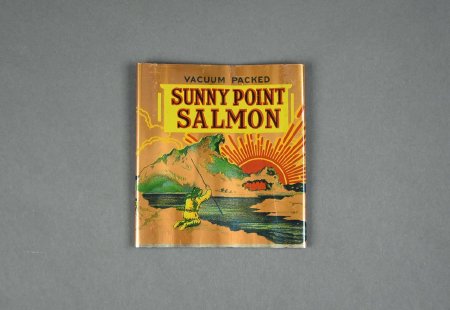Description:
July is for Shipping Salmon
When salmon were first packed in cans, all the cans were handmade, mostly by Chinese laborers. Space was a premium on the cannery ships coming to Alaska and room for workers was prioritized over bulky cargo like cans. In the weeks before the salmon runs, cannery crews assembled cans by cutting sheets of tin to size, shaping them into a round form, and soldering it all together. Imagine the labor it took to pack the 13 million cans exported in 1896 and the 34 million cans in 1901. If the soldering was shoddy cans would not seal properly, resulting in either loss or a softer twice-cooked product if the cans could be resealed. Around 1918, collapsed cans became available. They were shipped flat and reformed by machinery at the canneries ensuring a better quality product made it to market.
This month's featured artifact is an unformed one-pound can from the Sunny Point Cannery, which was located in the Charcoal Point area on Tongass Avenue. The artwork on the can was copyrighted in 1928. At that time the cannery was owned by the Skinner & Eddy Corporation in Seattle, who continued to use the Sunny Point name. The accompanying photograph shows a worker at Sunny Point loading flat cans into a machine called a reformer alongside cans that had already been rounded out. Once formed, cans passed on an assembly line to another machine where the bottom was attached. The partially assembled cans could then be filled with salmon. Full cans of fish passed through a topper to attach the top lid. Once filled and sealed, cans ended in the retort to be pressure cooked.
The photograph is part of a series of images taken by local photographer, Bill Lattin, showing the process of canning from offloading scow loads of fish to the final canned product. The photographs appear in a 1940 album assembled by Mildred "Millie" (Schmitz) DeMan, a 1939 Kayhi grad. While in high school, Millie and her sister worked at Sunny Point. Throughout the album Millie wrote descriptions of Lattin's photographs, explaining the canning process.
Object credit:
Ketchikan Museums: KM 2017.2.19.1
Image caption & credit:
Worker at Sunny Point Cannery loads flat cans into the reformer to be rounded out.
Ketchikan Museums: William Lattin image, KM 98.2.66.4 page 2


